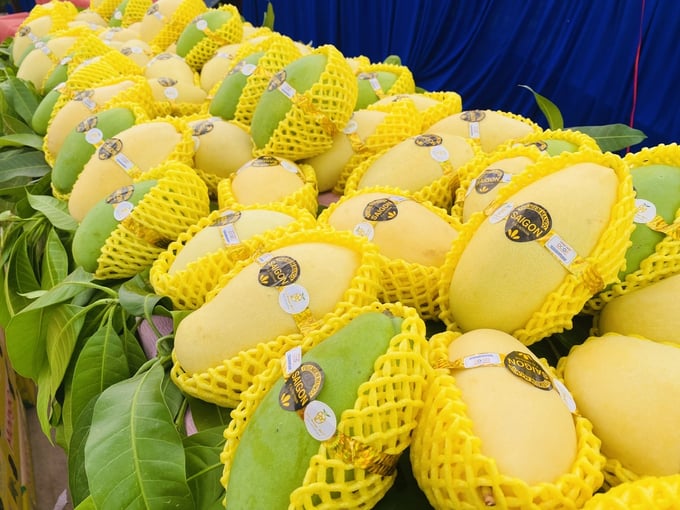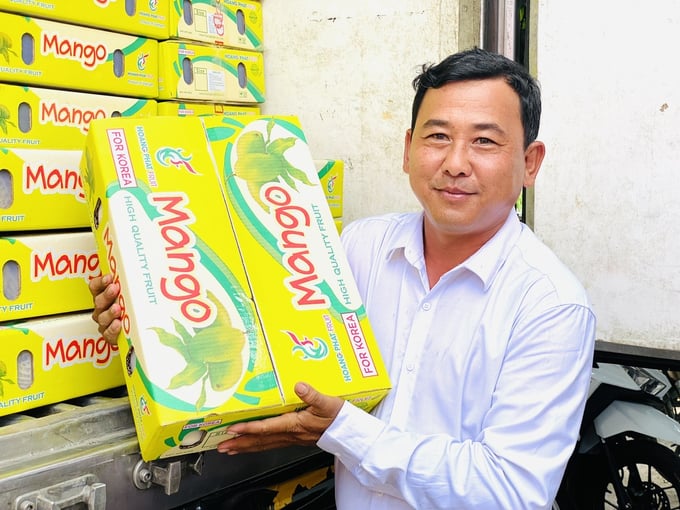November 27, 2025 | 00:34 GMT +7
November 27, 2025 | 00:34 GMT +7
Hotline: 0913.378.918
November 27, 2025 | 00:34 GMT +7
Hotline: 0913.378.918

An Giang is one of the two provinces with the largest mango cultivation area in the Mekong Delta, second only to Dong Thap, with over 12.000 hectares of various types of mangoes such as Keo mango, seedless mango and Hoa Loc mango. Photo: Le Hoang Vu.
An Giang is one of the two provinces with the largest mango-growing areas in the Mekong Delta, second only to Dong Thap, with over 12,000 hectares of various types of mangoes, such as Keo mango, seedless mango, and Hoa Loc mango. Despite its rich variety and exceptional quality, An Giang's mangoes are still mainly consumed in the domestic market, and the export volume remains modest.
In recent years, the mango-growing regions in An Giang have gradually shifted towards a more systematic production approach, meeting international standards in order to expand export markets. Over the past decade, the local agricultural sector, businesses, and cooperatives have made great efforts to meet the strict requirements of demanding markets such as the United States, Australia, and South Korea.
An Phu District, which borders Cambodia, has the second-largest mango-growing area in An Giang, following Cho Moi District. Currently, there are more than 600 hectares of mangoes produced under enterprise standards, with over 360 hectares being certified GlobalGAP. An Phu is in the process of building a well-organized and high-quality raw material area that ensures both safety and quality standards for production.

Currently, the mango regions in An Giang have been assigned over 20 export-standard codes, covering a total area of nearly 370 hectares. Photo: Le Hoang Vu.
Long Binh Agricultural Cooperative is a key partner in the Keo mango export supply chain in An Phu. Mr. Huynh Thanh Minh, the Director of Long Binh Agricultural Cooperative, shared that the cooperative was established in 2017. It currently has 25 members and collaborates in the cultivation of Keo mangoes on over 90 hectares of land. The cooperative places a strong emphasis on high production standards, ensuring that the mangoes are free from pesticide residues and meet the necessary export quality standards.
Mr. Le Thanh Tam, a member of Long Binh Agricultural Cooperative, further explained: "In mango production, we continuously invest in the application of modern scientific techniques to ensure the best quality for export purposes. At present, we are utilizing a biological pesticide spraying system through automated technology. Furthermore, we make a conscious effort to use organic fertilizers, minimize the use of chemical pesticides, and implement drip irrigation methods... all to reduce pesticide residues as much as possible, ensuring the satisfaction of both domestic and international consumers".
Cho Moi District, the area with the largest mango cultivation in the province, spanning nearly 6.500 hectares, has been placing special focus on the Green Skin mango variety, with over 4.200 hectares dedicated to it. Since 2009, many mango-growing areas in this district have been certified with VietGAP and have started to export high-quality mangoes that are not only beautiful and delicious but also meet the strict quality standards of demanding markets such as Australia, South Korea, and the United States.
Mr. Lam Anh Tu, the Deputy Head of the Agriculture and Environment Department in Cho Moi District, shared that, similar to other regions in the province, in addition to helping farmers implement advanced scientific and technological methods in mango production, the agricultural sector has also been actively assisting farmers in building and upgrading irrigation systems to support the development of mango cultivation areas. Moreover, the department organizes training sessions, conducts awareness campaigns, and encourages local farmers to adopt safe production practices while helping them obtain farm codes to meet the strict export standards required by international markets.
In mango export production, aside from strengthening the application of science and technology, farmers in the cooperative are also strongly promoting cooperation between farmer organizations, cooperatives, and businesses to boost production and consumption.

In recent years, businesses and cooperatives in An Giang have strengthened the linkage between mango production and consumption. Photo: Le Hoang Vu.
In recent years, businesses and cooperatives in An Giang have increasingly strengthened the link between mango production and consumption. Mr. Nguyen Dinh Muoi, Deputy General Director of Vina T&T Import-Export Co., Ltd, emphasized: "Vina T&T has always highly valued the quality of An Giang mangoes, which are grown in the fertile alluvial soil, resulting in mangoes that consistently meet high-quality standards. In the long term, Vina T&T is looking to build a sustainable partnership with farmers in order to expand the export markets for these products".
Mr. Tran Thanh Hiep, Deputy Director of the An Giang Department of Agriculture and Rural Development, mentioned: "Currently, the province has over 20.000 hectares of fruit trees, with approximately 17.200 hectares currently bearing fruit, mostly consisting of mangoes, bananas, longans, grapefruits, oranges and tangerines. In fact, mango farming brings farmers much higher profits compared to other agricultural models. For areas in the Giang River islands in Cho Moi District and An Phu District, which specialize in mango cultivation, the agricultural sector is providing substantial support for infrastructure development and irrigation systems, while guiding farmers to adopt VietGAP standards for mango cultivation.
Additionally, the sector is helping farmers obtain certifications for their products to ensure they meet export quality standards for high-end markets such as South Korea, Japan, Australia and the United States. Furthermore, the local government is creating conditions for businesses to build processing plants, establish stable consumption links, and develop sustainable models that reduce risks from overreliance on the Chinese market".

Mango farmers have obtained quality certification for export to high-end markets such as South Korea, Japan, Australia and the United States. Photo: Le Hoang Vu.
As of the present time, the total mango cultivation area in An Giang province is approximately 12.000 hectares. Among these, more than 300 hectares of mangoes are produced according to VietGAP standards, yielding around 1.900 tons per year. The mango regions in An Giang have been assigned more than 20 export-standard codes, covering a total area of nearly 370 hectares. However, in recent years, the consumption of mangoes has been primarily reliant on the domestic market and China. Although An Giang mangoes have recently gained entry into markets such as South Korea, the United States and Australia, the volume of exports remains relatively small.
According to the An Giang Department of Agriculture, the development of high-quality mango areas and the establishment of sustainable production and export linkages have initially confirmed the position of An Giang mangoes in demanding international markets. This is a significant turning point for the local agricultural industry, bringing not only substantial economic opportunities but also enhancing the image and reputation of local agricultural products in the international market. It also creates favorable conditions for the agriculture sector to continue reorganizing production, develop cooperatives, and link farmer groups to the mango raw material zones.
As a result, it will become easier to connect more mango cultivation areas within the province, contributing to the successful implementation of the province's agricultural restructuring plan. This will help transition production methods, adapt to actual conditions, overcome challenges, and promote the development of the agricultural economy.
Translated by Phuong Linh

(VAN) China’s cooking oil is suddenly flooding into India. It all comes down to a soybean surplus that Beijing doesn’t quite know what to do with.

(VAN) An Giang promotes supply-demand connections, standardizes quality and builds value chains, creating a foundation for sustainable bird’s nest development and aiming to expand exports.
/2025/11/24/5339-4-nongnghiep-075331.jpg)
(VAN) Recently, the conference on 'Sustainable Fisheries Linkage Chain - Tilapia for Export' took place in Tien Hai commune, Hung Yen province.
/2025/11/21/4309-2-153400_128.jpg)
(VAN) Green and low-emission rice is paving the way for Vietnamese rice to enter high-end markets, marking the beginning of a transformation journey toward greening and elevating the national rice brand.

(VAN) ‘Right to Win’ outlines a national action plan that shapes a new vision for Viet Nam’s agriculture in an era of renewal and global integration.

(VAN) Lam Dong’s farmed sturgeon output this year is expected to reach 2,300 tons, worth VND 450 billion, affirming the brand’s position on the market.

(VAN) A surge in Ukrainian egg exports, largely driven by soaring sales to the UK over the last few years, has notably pushed up egg prices on the domestic market.